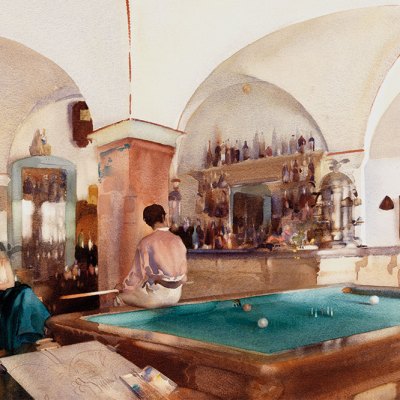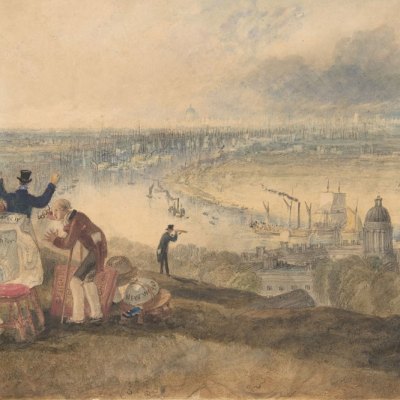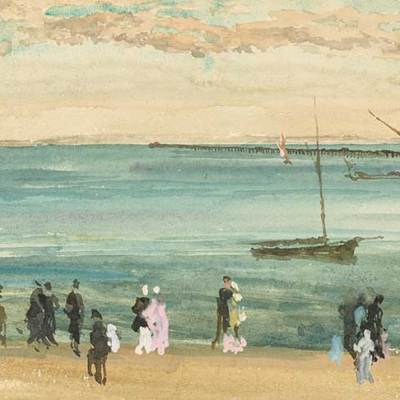From the May 2023 issue of Apollo. Preview and subscribe here.
Richard Foster Yarde (1939–2011) created Cunard Street, Interior II in 1980 as part of his Apartment Series. It stemmed from some earlier work in which he was interested in the exterior of domestic spaces, architectural facades, front stoops; of getting a sense of the neighbourhood where he grew up: Roxbury, a suburb of Boston. In this series Yarde reflects on his upbringing. He said that he wanted to embrace his memories. He was not looking to depict exact reflections of events, but to recapture something that he felt was disappearing. Over the course of his life he saw a lot of changes in what was an impoverished area with a lot of socio-economic problems and struggles. He felt that there was an erasure happening and he wanted to hold on to what was being lost.
He turned to watercolour, as he had most of his life. This work is a scene that he revisited in two separate instances, so he has a part one and a part two of the same scene. Part one has the same two figures, the woman on the left and the man in the bathtub – and what he imagines to be his brother Edgar sitting in a chair by the bathtub. His brother is omitted in the version that is in the Harvard collection, and this is important because Edgar died from pneumonia when he was around six years old. People think of watercolours as a happy and colourful and vibrant medium, but it can also be used for these moments that are challenging and personally difficult.
Yarde’s mother gave him a watercolour set when he was about six years old. He started taking classes in watercolour and sculpture at the Museum of Fine Arts, Boston. His godfather, the photographer Amos Gibson, had a studio in Boston, and Yarde helped him hand-tint the photographs in the studio, which were mainly portraits. This is where he developed a sense of the potential of watercolour. When he studied at Boston University, he turned to watercolour for sketches and studies when all the other students were using oil paint and graphite. It was here that he developed a strong feeling for the medium that stayed with him, and I think you can see why he was interested in using it for what is a melancholy scene.
I believe that the figure on the left is his mother, based on interviews with Yarde that refer to her as his mother.
While she does seem very small and childlike in the scene, this seems to be a deliberate effect of the painting, to capture his experience and her vulnerability.
My eye is always drawn to the background first: that yellow wall and the way that it’s colour-blocked, which is a technique he developed and returned to often. It started off a little bit more grid-like and then later in his work it became these softer colour blocks. You can see the delineations between the blocks, which echoes the tradition of quilting that influenced Yarde: he’s not afraid to show the tidelines and pools and drips that appear when the watercolour sets. While the technique seems decorative and animated, it is also intentional – to show what watercolour is and what it can do.
Cunard Street, Interior II (1980), Richard Foster Yarde. Harvard Art Museums/Fogg Museum, Cambridge

The use of vibrant, dynamic yellows and reds and blues and greens was something that appeared later in his career. Blues and greens often stand for skin tone in his work, as well as communicating shadow and darkness and a kind of despondency. It’s not merely an atmospheric component, but is meant to evoke emotional states and make you look beyond race. He was someone who didn’t want to be known just as a Black artist; he said that very plainly. But he also said he wasn’t going to shy away from speaking or rendering his own experience. I think this was a way to allow him to do that.
Early in his career Yarde celebrated African American history by looking to figures like Marcus Garvey and to the Civil Rights movement, and he pulled a lot of his source materials from the photographs of Black American photographer James Van Der Zee (1886–1983), who is perhaps best known for his chronicling of the Harlem Renaissance, from the 1920s. Yarde’s work was about recuperating that history and making sure it was not lost, but he never merely translated an image. He always said in art school that he never wanted to just copy an image, he always wanted to develop it into something else. He would take newspaper clippings and apply watercolour to them to isolate figures and things in a scene that he found compelling. Again I think it was a way for him to recapture African American history, reimagining it and making it into something beautiful and complex through watercolour.
From the late 1970s to the ’90s, Yarde skewed much more into the personal realm, especially after he got very sick. He suffered a few strokes in the late ’80s and early ’90s that left him in a convalescent state. During this period he delved into personal reflection both upon his illness and his state of being. He said that this was really a turning point for him. What he calls abstractions of memory and room paintings, such as this work, are more about him observing not only the world around him, but rendering his own experiences and place in the world in an expressive and unique manner.
The most exciting aspect of him as a watercolourist is his intervention with the paper or support on which he’s working. In Cunard Street, Interior II, Yarde creates the composition using multiple sheets of paper spliced together – a practice that the artist used repeatedly throughout his career. He said that he often started at the centre of the sheet and built up the composition and, as the scene developed, he would then adhere additional overlapping sheets to the work and have it grow. It was an exercise not only to heighten the psychic dimension of the scene, but also to respond to developments in art around him. Yarde was a trained artist, he studied for years, he had a Master’s in fine art, he taught as a professor for decades and for him to innovate in this way speaks to a lot of other artists in the exhibition, who also manipulate paper, such as Paul Feeley, Romare Bearden, Robert Motherwell, Alexander Calder, even.
Most people associate the mid century with abstraction and see that the practice of watercolour was great for exploring colour and shape. That’s interesting and true, but what does it really mean for an artist like Richard Foster Yarde? I started to think more and more of the origins of watercolour in America: how it developed post-Civil War, when the country was facing many challenges. The prevalence of watercolour at a time of adversity persisted throughout the key moments of American watercolour history. We have a resurgence of American watercolour during the Depression in the 1920s and ’30s. Watercolour becomes an American medium, so what does that mean in the 1960s, another period of turmoil? Certainly there are artists who are working in abstraction, but when you look a little bit deeper you have artists such as Philip Guston, Alfonso Ossorio, Ben Shahn. A lot of these artists were turning to watercolour to render things that are about adversity, not just socio-political but also personal. This is where watercolour becomes a really resilient medium and Yarde is in in dialogue with all of these key figures and their themes.
When I first began to examine Harvard’s collection, I was struck by a select group of watercolours whose subject matter addressed moments of adversity or personal struggle. What emerged was a cohort of artists who were diverse in their artistic practice, who were women, who were immigrants, who were artists of colour. In a similar way, throughout his career Yarde never shied away from subject matter that was not typically expected of American watercolours. And this was freeing: by the mid 20th century the American Watercolour Society no longer dictated anything – anything goes.
Yarde himself talked about how he never achieved great fame, because he was really skittish around the commercialisation of his work. But more broadly within that, there was the fact that people considered his work as the mere recreation of photographs, or that he was simply illustrating domestic interior scenes. They did not see any innovation in his work or his methods. I have gone through I don’t know how many watercolour survey catalogues from the past few years and you really cannot see an effort to fit this type of work into the broader narrative of American watercolour, particularly after 1950. Yarde has a certain reputation as a local artist and part of local history but, as Oliver Shell at the Baltimore Museum of Art noted, when the museum devoted a show to Yarde at the end of 2021, it is time to reassess him beyond his ties to New England. We are trying to bring this artist and this work back into the light.
As told to Edward Behrens.
Elisa Germán is the co-curator of ‘American Watercolors, 1880–1990: Into the Light’, which is at the Harvard Art Museums, Cambridge, from 20 May–13 August.
From the May 2023 issue of Apollo. Preview and subscribe here.


